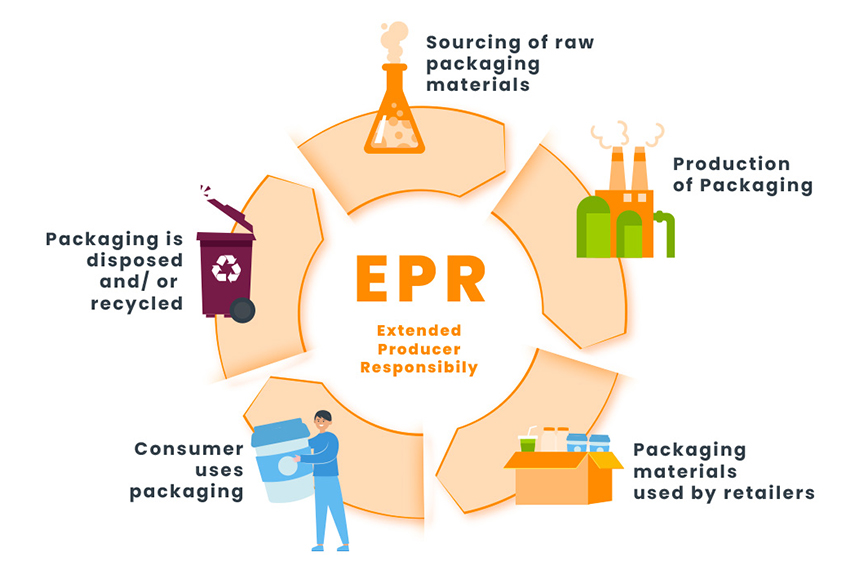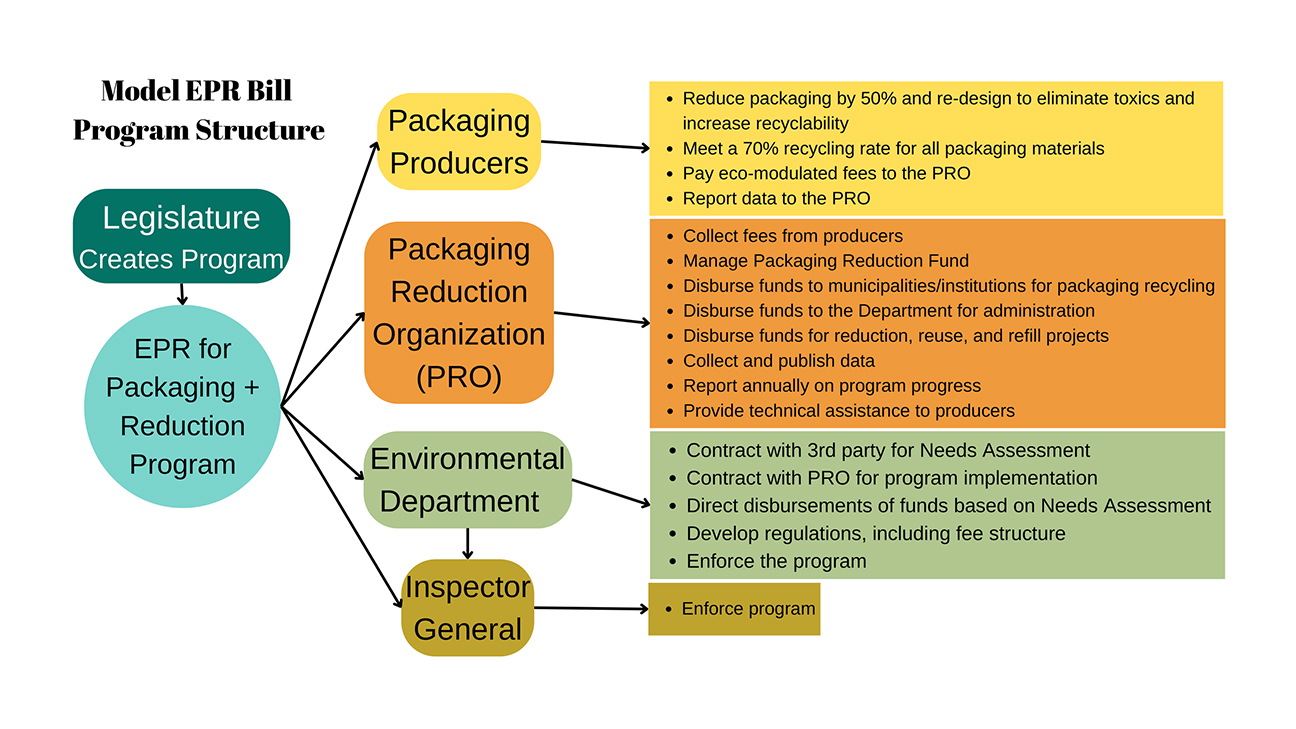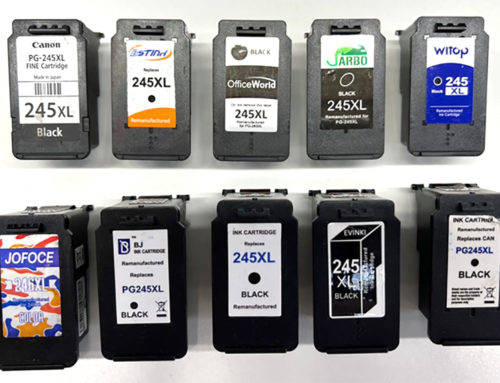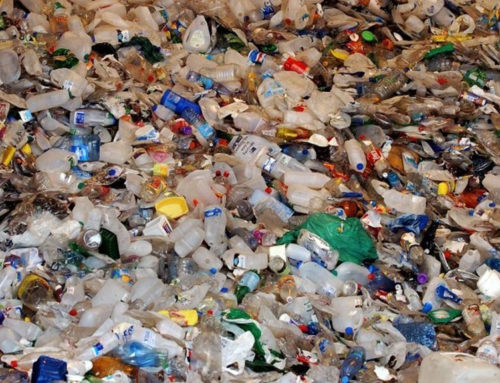Extended Producer Responsibility (EPR) regulations, a global practice, establish accountability for product manufacturers throughout their products’ life cycles. While EPR laws have been prominent in Europe and Canada, they are increasingly emerging at the state level in the United States. While several U.S. states have already enacted Extended Producer Responsibility regulations for products such as e-waste and batteries, the recent surge in EPR laws has predominantly targeted packaging materials, paper and plastic products, and food service ware. This update provides an overview of the existing Extended Producer Responsibility packaging laws in the United States, sheds light on proposed EPR packaging legislation, and outlines essential compliance obligations that manufacturers need to be ready for.
The key components of EPR packaging laws typically encompass the following aspects:
- Covered Products: EPR packaging laws precisely define the types of products subject to extended responsibility, often focusing on items like single-use packaging. These laws may further categorize covered products based on their materials, such as plastics or paper.
- Covered Producers: EPR packaging laws apply to “producers,” a term usually encompassing manufacturers, brand owners or licensees, and importers/distributors. However, certain entities like small businesses, governments, charities, and retailers may be exempt from producer obligations under these laws in many cases.
- Producer Responsibility Organization: Central to EPR packaging laws is the concept of the Producer Responsibility Organization (PRO). PROs bear the primary responsibility for complying with EPR packaging requirements, and they may be composed of individual producers or formed as a collective of producers. In some states, a designated PRO or a contracted stewardship organization oversees the program, while others mandate that producers establish PROs. A few states might require producers to directly register with the state and meet prescribed targets related to recycled content, recycling rates, and product composition.
- Fees: To support producer obligations, EPR packaging laws institute fee payments. These fees can be fixed rates or variable rates dependent on factors like product type and the volume of products sold or distributed within the state.
- Targets: Many EPR packaging laws introduce phased targets related to recycled content, recycling rates, and product composition, encouraging a gradual transition toward more sustainable packaging practices.
- Other Requirements: EPR packaging laws often include a wide range of additional mandates for covered producers. These requirements might encompass infrastructure enhancements, educational and outreach initiatives, labor-related stipulations, and comprehensive reporting obligations.

An overview of the current EPR packaging legislation in various U.S. states reveals the following developments:
- California: California has enacted the Plastic Pollution Prevention and Packaging Producer Responsibility Act. This law mandates a producer responsibility program for single-use packaging and plastic single-use food service ware. Producers of covered materials must fulfill plastic source reduction criteria, ensure recyclability or compostability of covered materials, and meet phased percentage recycling rates. They are also required to establish or join a Producer Responsibility Organization (PRO) by January 1, 2024, with exceptions in place.
- Colorado: Colorado’s Producer Responsibility Program for Statewide Recycling Act is focused on producers of single- or short-term use packaging materials and paper products, including food and beverage packaging. The state has designated a PRO that producers must become part of by June 1, 2025.
- Maine: Maine’s Act To Support and Improve Municipal Recycling Programs and Save Taxpayer Money introduces a producer responsibility program for packaging material. Producers must contribute to a fund based on the volume and recyclability of packaging associated with their products. The Department of Environmental Protection (DEP) will select a stewardship organization (SO) to administer the program. Producers are expected to comply with and fund the program within a year, although the DEP does not anticipate selecting an SO until 2026.
- Oregon: Oregon’s Plastic Pollution and Recycling Modernization Act establishes a producer responsibility program that necessitates producers of covered products, including packaging, printing and writing paper, and food service ware, to join and financially support a PRO. Producers must register with the PRO and pay annual fees following the program’s implementation on July 1, 2025.
- New Jersey: While not a comprehensive EPR law, New Jersey’s Recycled Content Law sets postconsumer recycled content requirements for various products, including rigid plastic containers, glass containers, paper and plastic carryout bags, and plastic trash bags. It also prohibits the sale of polystyrene loose fill packaging. Manufacturers were required to register annually starting in July 2022, with recycled content standards taking effect in January 2024.
- Washington: Similar to New Jersey, Washington’s Plastics Law establishes a producer registration and reporting system, along with labeling and minimum-recycled-content requirements for specific plastic products. The Washington Department of Ecology is in the process of implementing these rules, expected to take effect in January 2024. Producers had to register with the Department of Ecology by April 1 of each year, starting in 2022.
- Connecticut: Connecticut’s HB 6664, passed in its 2023 legislative session, introduces a registration program for producers of plastic beverage containers beginning in April 2026. It also establishes phased minimum post-consumer recycled content requirements for plastic beverage containers.
These state-level EPR packaging laws signify a growing trend in the United States toward holding producers responsible for the environmental impact of their products and packaging materials, with a focus on recycling, recyclability, and sustainability.

Proposed EPR Packaging Legislation
Numerous states have proposed EPR packaging legislation in 2023, including: Connecticut, Hawaii, Illinois, Maryland, Massachusetts, New Jersey, New York, North Carolina, Rhode Island, Tennessee, and Washington.
Compliance with EPR (Extended Producer Responsibility) packaging laws in the United States involves several critical steps for covered producers:
- Stay Informed: It’s crucial to stay updated and informed about the specific deadlines and requirements of EPR packaging laws in the states where you operate. Compliance deadlines can vary significantly from state to state, and understanding these variances is essential.
- Registration: Covered producers typically need to register with the relevant state agencies to demonstrate their commitment to meeting EPR obligations. In some cases, you may need to establish or join a Producer Responsibility Organization (PRO) or a stewardship organization, as mandated by the state’s law.
- Collaborate with Suppliers: Work closely with your suppliers to ensure that the materials and products you receive align with the phased recycled content, recyclability, or composition requirements specified in the state’s EPR packaging laws. This collaboration is essential to meeting compliance standards.
- Record-Keeping: Prepare to maintain detailed records as part of your reporting obligations. This typically includes documenting the types of covered materials you sell, offer for sale, import, or distribute within the state each year. You’ll also need to keep records of universal product codes (UPC) and brand names of products containing covered materials, along with the weight and/or volume of covered materials involved in your operations annually. Additionally, you must track the postconsumer recycled content of covered materials.
- Engage with Regulators: Consider engaging with state regulators as they develop and implement regulations related to EPR packaging requirements. Some states, such as California, Colorado, Maine, and Oregon, have ongoing rulemaking efforts that may offer opportunities for public comment. Your involvement can help shape regulations and ensure they align with your industry’s needs and capabilities.
Compliance with EPR packaging laws is not only essential to meet legal obligations but also contributes to sustainability and environmental responsibility. By following these steps and actively participating in the regulatory process, covered producers can effectively navigate the evolving landscape of EPR packaging legislation in the United States.
The implementation of Extended Producer Responsibility (EPR) packaging laws in the United States has several implications for the common consumer:
- Impact on Product Availability: EPR laws may lead to changes in the types of packaging materials used for products. For example, there may be a shift toward more recyclable or environmentally friendly packaging. Consumers may notice changes in the packaging of products they purchase.
- Potential Cost Implications: Depending on how EPR fees are passed on to consumers, there could be potential cost implications. If manufacturers and producers pass on the fees associated with EPR compliance to consumers, it could lead to slight price increases for certain products. However, this may be offset by the long-term benefits of improved recycling and reduced environmental impact.
- Awareness of Recycling and Sustainability: EPR laws often come with increased awareness campaigns about recycling and sustainability. Consumers may receive more information about how to properly recycle packaging materials and reduce waste. This could lead to a more informed and environmentally conscious consumer base.
- Product Labeling: EPR laws may require clearer product labeling regarding recycling and disposal. Consumers may see labels indicating whether a product is recyclable, made from recycled materials, or subject to specific recycling requirements. This can help consumers make more informed choices.
- Influence on Purchasing Decisions: Some consumers may start considering a company’s environmental responsibility and compliance with EPR laws when making purchasing decisions. Companies that prioritize sustainability and EPR compliance may gain a competitive edge in the market.
- Job Creation: In some cases, EPR laws may lead to job creation, particularly in recycling and waste management sectors. This can have positive economic implications for local communities.
In essence, EPR packaging laws aim to shift the responsibility for managing packaging waste from consumers and local governments to producers and manufacturers. While there may be some short-term adjustments and potential cost considerations, the long-term benefits include reduced environmental impact, improved recycling practices, and a more sustainable approach to packaging and product lifecycle management. The consumers can contribute by participating in recycling programs, following recycling guidelines, and making informed choices that align with sustainability goals.






